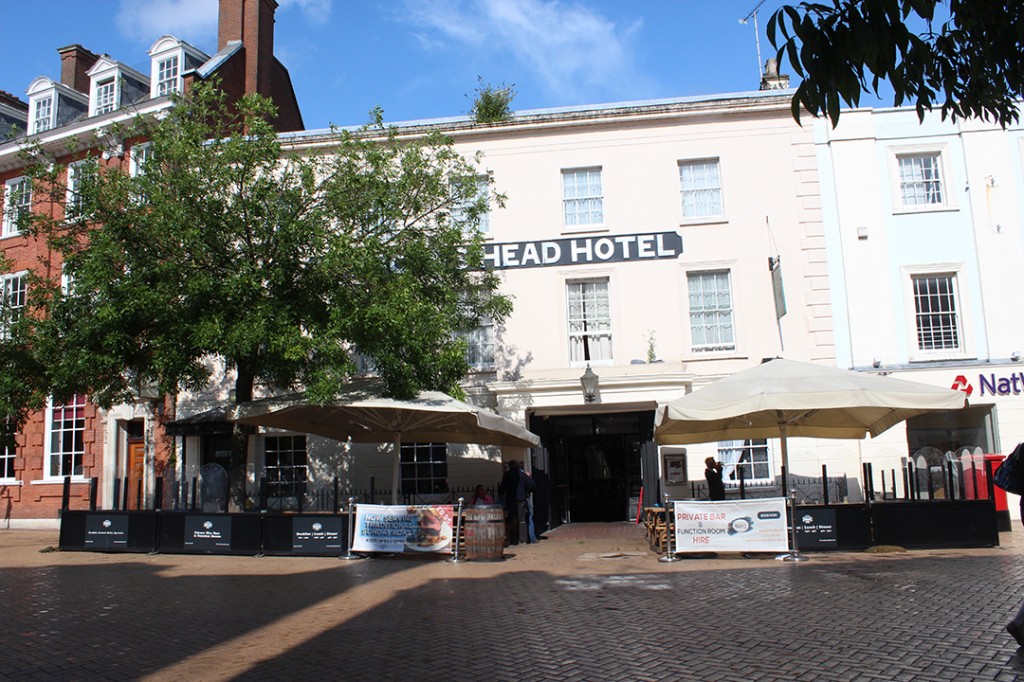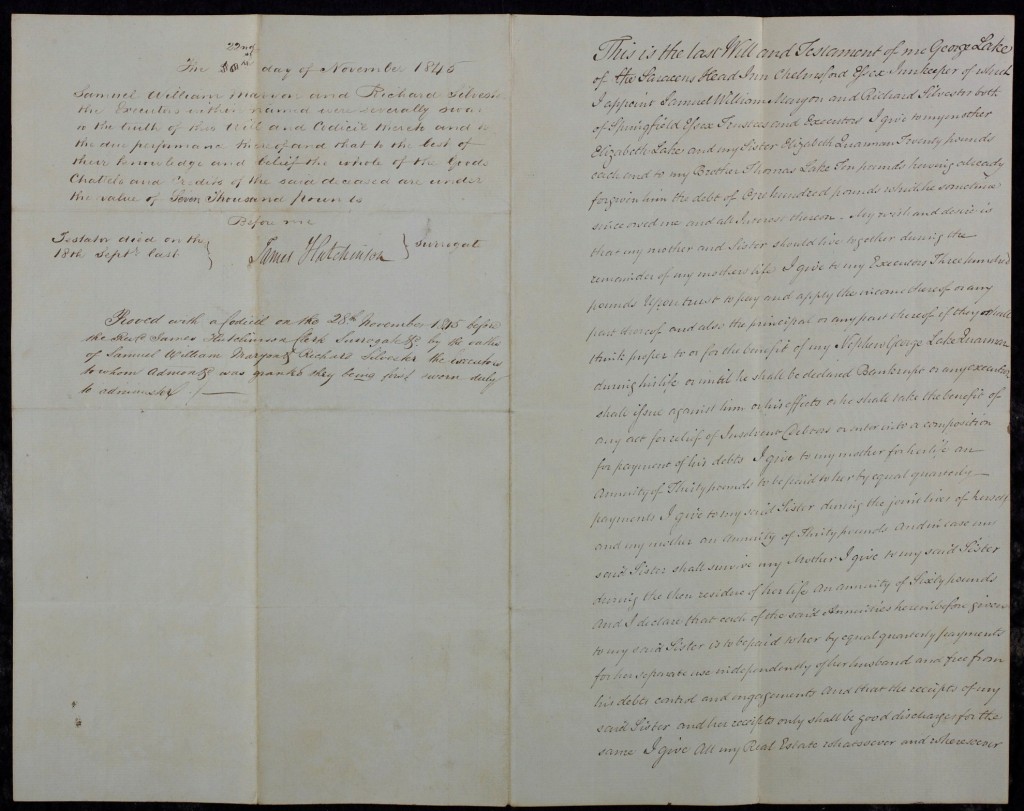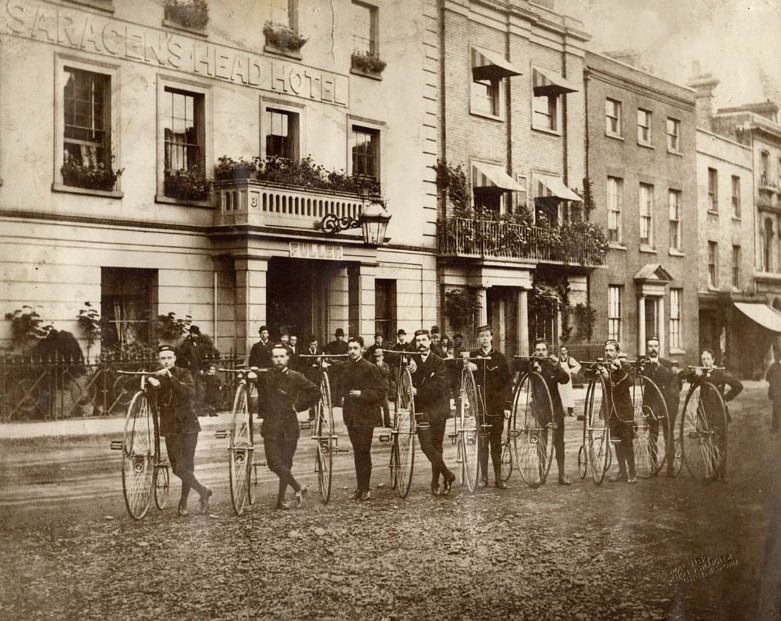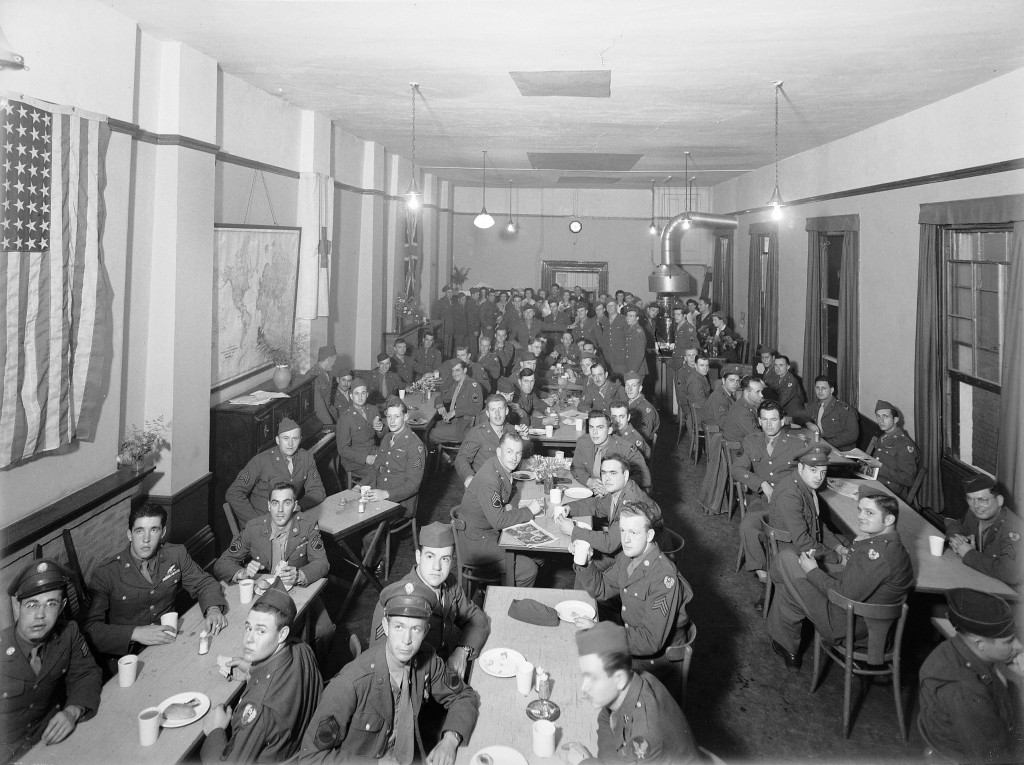In the second in our series looking at the history of Chelmsford High Street, Ashleigh Hudson looks at the Saracen’s Head Hotel. Find out more about the project here.
The Saracen’s Head was first recorded on the site of Number 3 High Street in 16th century parish registers. Remarkably the Saracen’s Head continues to occupy the same site today, having served as a popular and well frequented establishment for nearly five hundred years.

Extract from the 1591 Walker map of Chelmsford. The Saracen’s Head is the third building down on the eastern side of the High Street, opposite the old Market Cross, where the market and court hearings took place. The property backs onto ‘Saracen’s Head Meade’ (D/DM P1).
John Walker’s map of Chelmsford includes eleven inns dotted along the high street in the 16th century. On the site of 3 High Street sat The Saracen’s Head inn; a large, two storey property constructed from timber. Chelmsford was ideally situated on the road to London and therefore made a welcome resting point for weary travellers. The survey which accompanies Walker’s map tells us that Richard Brett was in charge at the time:
The Sarazens Hedd – an Inn with buildings, gardens, curtilages, and orchards, Richard Brett also holds a piece of waste in front of the Sarazens hedd in length “xv foote of assise and in breadeth Easte and West vj foote, for moveable stalles to be used in the market time.”
The Saracen’s Head grew into one of the largest inns on the high street, boasting an impressive 18 hearths according the Hearth Tax Assessment conducted in 1671.
Chelmsford’s growing prosperity and increasing trade facilitated the redevelopment of the property in the early 18th century. Owner Thomas Nicholls took a second mortgage out on the Saracen’s Head, describing the property as ‘lately erected and new built’ in 1724. Development came at a price and unfortunately Nicholls was unequipped to pay it. He defaulted on the mortgage repayments and the property subsequently passed to William Taylor. Despite Nicholls’ personal financial shortcomings, the Saracen’s Head continued to prosper into the 19th century. We are fortunate to have a beautifully written will belonging to Saracen’s Head innkeeper George Lake which reveals the growing wealth of the town’s tradesmen. Lake was able to bequeath twenty pounds each to his mother and sister as well as an annuity of thirty pounds to be paid over their lifetime. While many of the original Tudor inns were either demolished or replaced by various retail establishments, the Saracen’s Head continued to thrive and proved itself a profitable establishment.
From the late 18th century, inns increasingly provided an important social space in the heart of town. The Saracen’s Head, as one of the largest inns on the high street, was a popular venue of choice and hosted a whole range of activities, clubs and events.
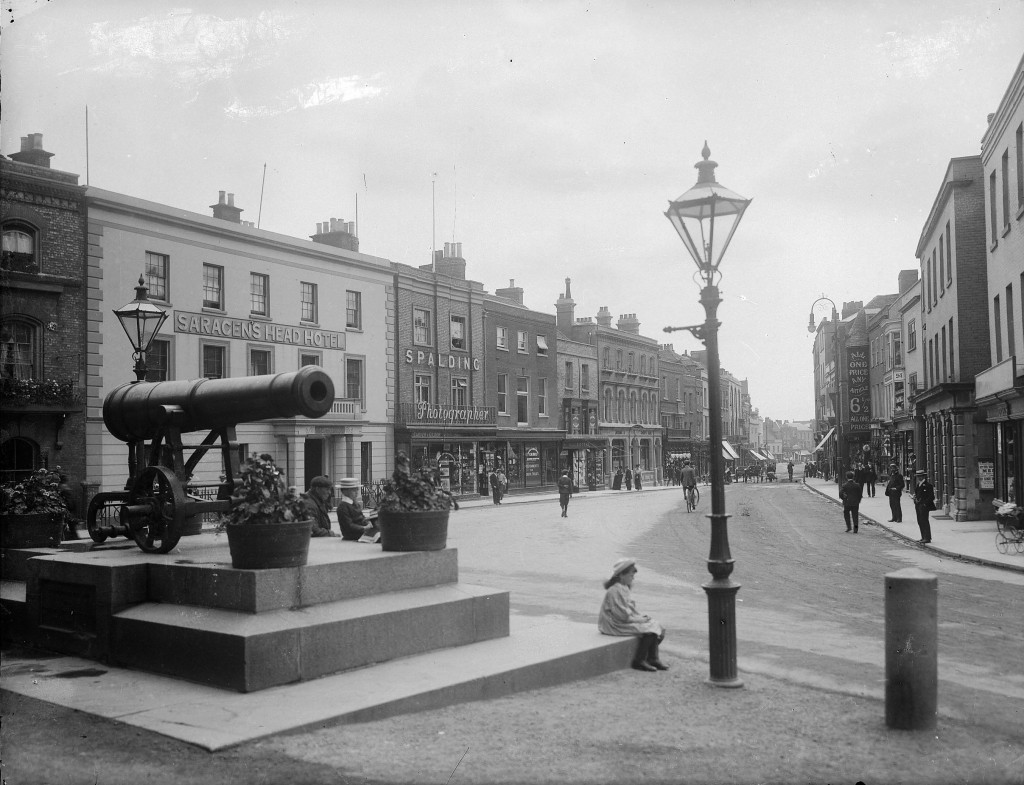
Photograph taken from the north end of the High Street in the late 19th century. The Saracen’s Head can be seen just behind the Sebastopol Cannon which has since been moved to Oaklands Park.
The Chelmsford Beefsteak Club met once a month at the inn where they had their own cellar reserved. Every summer the inn accommodated the Flowerists feast and prior to the construction of the Shire Hall in 1791, the Saracen’s Head hosted various concerts and balls. Advertisements were frequently placed in local newspapers announcing the events which attracted visitors from across the county.
The Saracen’s Head was equally popular with local residents, who perhaps appreciated the long history of the ancient establishment. Mayor of Chelmsford Frederick Spalding recalled:
“…the little back room, which I remember very well, was what one might call a club room, because every seat in it during the evening was occupied by some well-known resident of Chelmsford… If you were at any time permitted to go into this room and happened to seat yourself on any particular chair you would be politely told that at 7 o’clock, when Mr. – came in, you would have to vacate it.”
During the Second World War, the Saracen’s Head opened its doors to the American Red Cross. Known locally as the ‘American Club’, the hostel provided sleeping accommodation for up to 30 men as well as providing meals for up to 300 soldiers per day. The hostel was kept separate from the Saracen Head’s main bars and even had its own entrance. The Chelmsford Chronicle hastened to reassure residents that the opening of the American Club ‘would in no way affect the bars, which will be carried on as usual’.
The American officers were a visible and constant presence on the High Street during the war years. The photograph below captured in 1942 depicts numerous American officers, dressed in full uniform, posing outside the Saracen’s Head. A large sign reading ‘American Red Cross Service Club’ dominates the main entrance, while an American flag flutters overhead.
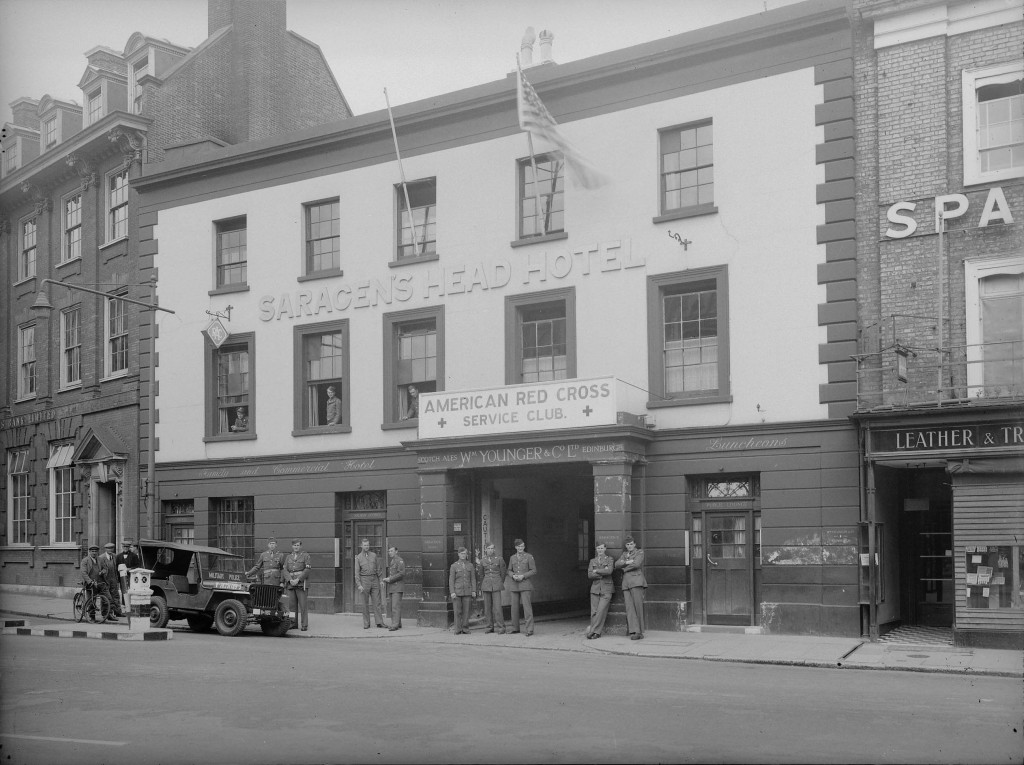
The Saracen’s Head Hotel during the Second World War when it was used as a club for the American Armed Forces. (SCN 552)
The hostel also acted as an important social hub where American soldiers could relax and mix with the locals. In the photograph below numerous American officers can be seen relaxing inside the hostel, clearly enjoying the comfortable and even homely interiors.
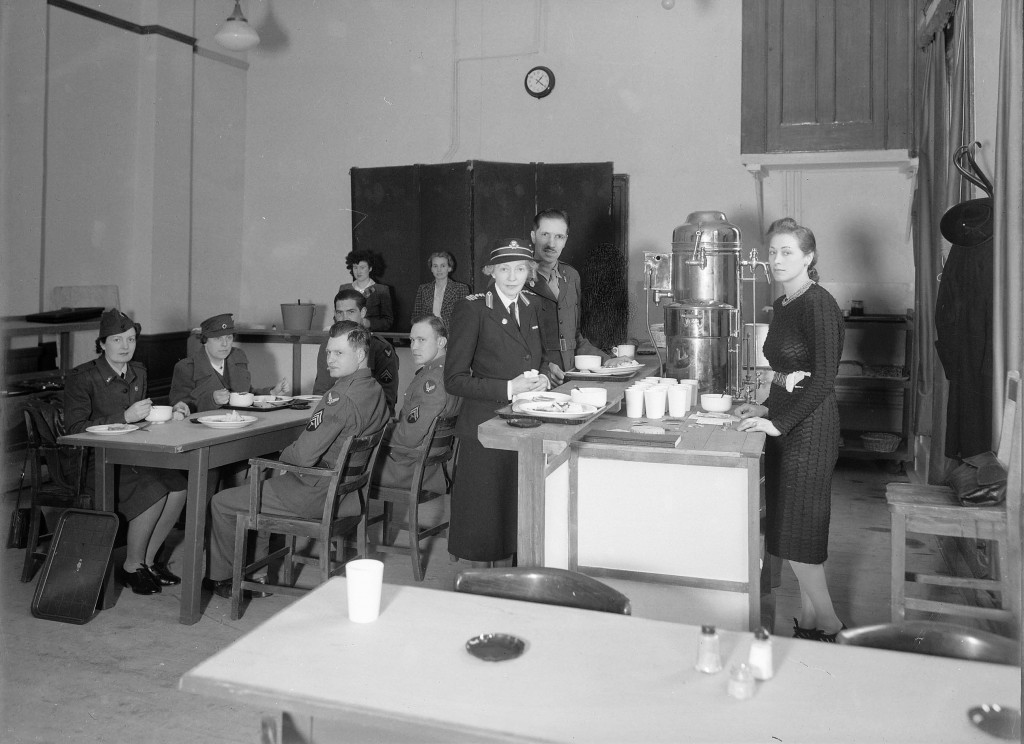
Over 150 women from the Chelmsford area volunteered their services at the new American Club. (SCN 548)
The American officers reportedly enjoyed their time in Chelmsford with a survey conducted by the Chronicle establishing that 32 out of 40 American soldiers very much liked Chelmsford, although all were excited to ultimately get back home. A young American Lieutenant is quoted:
“Your town is much bigger, and has more services than we expected… We have been very agreeably surprised. Many of our boys are now almost members of some Chelmsford families, who took the initiative in the early days of our arrival and made us so much at home… Most of us think that Chelmsford is a real swell place, with grand people in it.”
The ‘American Club’ came to represent a period of harmonious relations between Britain and the US. Over 150 young women in Chelmsford volunteered to work at the club and countless Chelmsford residents interacted with the American soldiers socially on a daily basis. Such was the legacy of these relations, both in Chelmsford and Essex as a whole, that the Essex Anglo-American Goodwill Association was created to foster continued relations and perhaps engage with Americans who were sent here as soldiers, but who might one day return as tourists.
By the end of July 1945, the ‘American Club’ closed, although the Saracen’s Head did not officially resume pre-war functionality until 1948. In January of that year the Essex Newsman warmly declared ‘Welcome back the Saracen’s Head!’ noting that after the long period of war service the hotel was at last able to come into its own again.
Many inns have disappeared from the High Street since the creation of the Walker map in 1591, but the Saracen’s Head continues to operate under the same name and from the same site as in the 16th century. This extraordinary achievement is a testament to the popularity of the premises in question. Nonetheless, the nature of the business has changed a great deal over time. Originally a resting point for weary travellers, the Saracen’s Head increasingly became a social establishment, providing an entertaining venue for visitors and residents alike. Today the Saracen’s Head is a popular social destination for a whole new generation of Chelmsford residents.
If you would like to find out more about this ancient building, try searching for the Saracen’s Head on Seax. Alternatively see Hilda Grieves’s detailed history of Chelmsford The Sleepers and The Shadows in the ERO Library.

